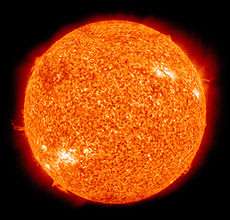Coronal hole
Coronal holes are areas where the Sun's corona is colder, hence darker, and has lower-density plasma than average because there is lower energy and gas levels. Coronal holes are part of the Sun's corona and are constantly changing and reshaping because the corona is not uniform.[1] The Sun contains magnetic fields that arch away from areas in the corona that are very thin due to the lower levels of energy and gas,[1] which cause coronal holes to appear when they do not fall back. Thus, solar particles escape at a rate great enough to create a lower density and lower temperature in that area.[2]

First discoveries
In the 1960s, they showed up on X-ray images taken by sounding rockets and in observations at radio wavelengths by the Sydney Chris Cross radio telescope, but at the time it was unclear what they were. Their true nature was recognized in the 1970s when X-ray telescopes in the Skylab mission were flown above the Earth's atmosphere to reveal the structure of the corona.[2][3]
Solar cycle
Coronal hole size and population correspond with the solar cycle.[3] As the Sun heads toward solar maximum the coronal holes move closer and closer to the Sun's poles.[3] During solar maximum, the number of coronal holes decreases until the magnetic fields on the Sun reverse. Afterwards new coronal holes appear near the new poles. The coronal holes then increase in size and number, extending farther from the poles as the Sun moves toward solar minimum again.[4] There are permanent coronal holes on the north and south poles of the Sun.[1]
Coronal holes and solar wind
Coronal holes generally discharge solar wind at a speed about twice the average.[3] The escaping solar wind is known to travel along open magnetic field lines that pass through the coronal hole area.[4] Since coronal holes are regions in the Sun's corona that have much lower densities and temperatures than most of the corona, these regions are very thin. This thinness contributes to the solar wind since particles within the chromosphere can more easily break through.
Influence on space weather
During solar minima coronal holes are the primary sources of space weather disturbances. Typically, geomagnetic (and proton) storms originating from coronal holes have a gradual commencement (over hours) and are not as severe as storms caused by coronal mass ejections (CMEs), which usually have a sudden onset. Due to the fact coronal holes can last for several months, it is often possible to predict the recurrence of this type of disturbance significantly farther in advance than for CME related disturbances.[2]
Images

See also
References
- Freedman, Roger A., and William J. Kaufmann III. "Our Star, the Sun." Universe. 8th ed. New York: W.H. Freeman, 2008. 419–420. Print.
- What is a Coronal Hole? ips.gov.au
- "Massive Coronal Hole on the Sun". NASA. NASA. Retrieved 31 October 2014.
- Fox, Karen. "Large Coronal Hole Near the Sun's North Pole". NASA. NASA. Retrieved 31 October 2014.
Further reading
- Gombosi, Tamas (1998). Physics of the Space Environment. New York: Cambridge University Press. ISBN 0-521-59264-X.
- Jiang, Y., Chen, H., Shen, Y., Yang, L., & Li, K. (2007, January). Hα dimming associated with the eruption of a coronal sigmoid in the quiet Sun. Solar Physics, 240(1), 77–87.
